Project Category: Civil

Join Our Presentation:
About our project
A successful municipal roadway has to be developed around the needs and tendencies of those who use it. Consumers purchasing goods and bringing them home greatly contributes to the overall transportation load on a city’s road system.
We have designed a survey named “The Edmonton Online Survey of Shopping Activity (EOSSA)”, which will be administered to 12,000 Edmonton households. The respondents are members of the “Edmonton Insight Community”, a volunteer group aimed to regularly provide citizen feedback to the city. We’ve designed the survey to contain five fundamental purchasing groups: cooked foods, groceries, clothes, furniture/appliances, and electronics. The survey questions in each group investigate the purchase frequency, travel, and monetary value of the goods.
Our survey is completed and has obtained ethics approval from both the University of Calgary and the City of Edmonton. The survey is now ready to be administered and the resulting data be used to formulate utility functions that reflect the shopping behavior of Edmonton citizens. These findings will be used to improve Edmonton roadway networks and modernize them for current shopping/delivery trends.
Watch our Youtube Video:
Meet our team members
| Clare Salango | Dan Cihelka | Mo Yassin | Yuesong Ding | Zichen Xing |
|---|---|---|---|---|
 |  |  |  |  |
Details about our design
HOW OUR DESIGN ADDRESSES PRACTICAL ISSUES
In order to develop a successful municipal roadway transportation network, it must be developed around the needs and tendencies of those using it. Otherwise, scenarios such as slow travel time, packed parking lots, and traffic jams will arise.
It is only possible to predict these needs and tendencies by surveying the public and drawing conclusions based on the results. One of the most common reasons for transport is goods acquisition, that is, bringing goods from retail stores or restaurants and taking them home. The project has designed a survey to track the individual tendencies and behaviours concerning goods behaviour in the city of Edmonton.
The results and considerations from our survey data will be inputted into future City of Edmonton roadway models. This will ensure the Edmonton roadways will be designed the most effective way for the people who are using it most.
WHAT MAKES OUR DESIGN INNOVATIVE
Our design incorporates many innovative aspects within the survey primarily related to the collection of the stated preference data. In traditional travel monitoring surveys, stated preference data is collected from a simple question where someone would compare how they travelled or purchased something with another scenario that has some changed variables. This is usually done by comparing 1 or 2 of these alternative scenarios at a time. Our design displays 4 total alternatives, including what the participant actually did, of which the participant would drag and drop to order them. They would place the most preferred option on the very top to the least preferred at the bottom. This allows collection of the stated preference data in a very efficient manner as the users can compare these alternatives in a very user friendly interface. This is also very efficient in that it allows the comparison of 4 alternatives and thus the impact of 4 different variables in one question.
Our design is also able to measure the impact of COVID-19 on how people in Edmonton purchase and get their goods delivered. Rather than just having a generic question asking users how COVID-19 has impacted their choices or if it has changed their behaviour, our question takes them through the stated preference questions in the present time and then the following questions asks them to imagine COVID-19 was not present and to reorder these alternative scenarios. We are able to directly compare their actions now vs pre-COVID and thus we are able to treat and measure COVID-19 as a variable in purchasing and delivering goods to their home. This systematic approach could also be a template for future pandemics or events that greatly impact travel behaviour.
WHAT MAKES OUR DESIGN SOLUTION EFFECTIVE
To ensure the survey is effective, the group continually collaborated with industrial and academic supervisors, and also took advantage of external resources, such as HostedInCanada Surveys. Below are some of the considerations taken during the survey design process to ensure an effective design.
Since the survey will help the City of Edmonton advance its transportation system, we designed questions that are specific to Edmonton travellers, such as questions regarding the “Light Rail Transit (LRT) system”. We are also collecting information from one of the most committed groups in Edmonton, the volunteer Edmonton Insight Group. Members of this group consistently show their interest in public development, so we have very minimal concerns regarding quality of responses..
Our survey also breaks shopping trips into five categories, which were carefully discussed between the group, advisors, and external mentors to ensure they cover all potential shopping experiences. We also ask specific questions to compare shopping habits with and without the presence of COVID-19. Upon analyzing all survey responses, our data should represent many diverse scenarios.
Finally, the survey has passed a full ethics-review from the University of Calgary. This means that all of the questions shown in the survey should be ethical, effective, and critical. We have modified any questions that may potentially confuse participants – so the survey will be very straightforward and reasonably segmented once it is administered.
HOW WE VALIDATED OUR DESIGN SOLUTION
We’ve validated our design solution by using a four step approach.
First, while designing the survey, we constantly checked if there were any minor errors in terms of grammar, misspelling etc. We also met once a week with our advisors to fix any errors and make modifications. Examples of these modifications include adding missing choices of transportation or changing the question styles to fit the survey better.
After the initial design, we had a meaningful discussion with both our academic and industry advisors. We presented our design and were provided with their insights and feedback. For example, as a result of this discussion, we added the “Electronics” section into our survey to cover more shopping areas. We also doubled the stated preference questions to make the survey more comprehensive.
We then moved to quality checking our final design, this included reviewing any particular ethical considerations we need to add, any language complication we can ease, and potential coding errors. We also discussed risks of our projects during this process.
Finally, our team presented the survey design to individuals at the City of Edmonton and received positive feedback that encouraged our team to file the UCalgary ethics application and publish the survey for initial beta testing. We continue to monitor the survey and fix any new errors that appear before it is officially sent to the Edmonton Insight Community.
FEASIBILITY OF OUR DESIGN SOLUTION
Our completed survey design, which includes the questions and all the logical flow, can be used to analyze the shopping behaviours in a city similar to Edmonton. Considering COVID-19 is a global pandemic, most places that are more technologically advanced will be able to adapt the survey to identify the different tendencies that changed in most individual shopping behaviours.
We gather data in two different ways; The first is by asking about a recent purchase, which helps us discern a person’s shopping behaviours. The other way is by asking stated preference questions, this allows us to see which aspects of a trip had more influence in comparison to others. For example, if free shipping is more important than an overall discount on an item. Using these two basic concepts, we will be able to better understand the shopping behaviours of the citizens of Edmonton.
The survey also accounts for the diversity of a population and how certain internal and external factors could affect a single shopping trip. The resulting data from the survey is intended to be used to improve existing roadways and create better ones for the citizens of Edmonton. Similarly, the survey can be used to improve the transportation systems in other cities, or in general, optimize how people bring their goods home whether that be through online delivery services or bringing them home themselves.
Partners and mentors
We want to thank the many people who helped us out with this project:
- Dr. John Douglas Hunt patiently guided us through the full survey design process by providing his wealth of knowledge and design insights.
- Arun Bhowmick and Sandeep Datla consistently responded to our requests with advice and feedback from the City of Edmonton and the Edmonton Insight Group
- Jacob Lamb provided us with project management resources and strategies so that all our project deliverables were effectively scheduled and completed on time.
- Kevin Stefan allowed us to streamline our survey design by giving us survey software tips and question implementation instructions based on his previous surveys.
- The University of Calgary Conjoint Faculties Research Ethics Board consistently answered our questions which allowed us to complete our ethics application quickly and efficiently.
 |  |
Our photo gallery
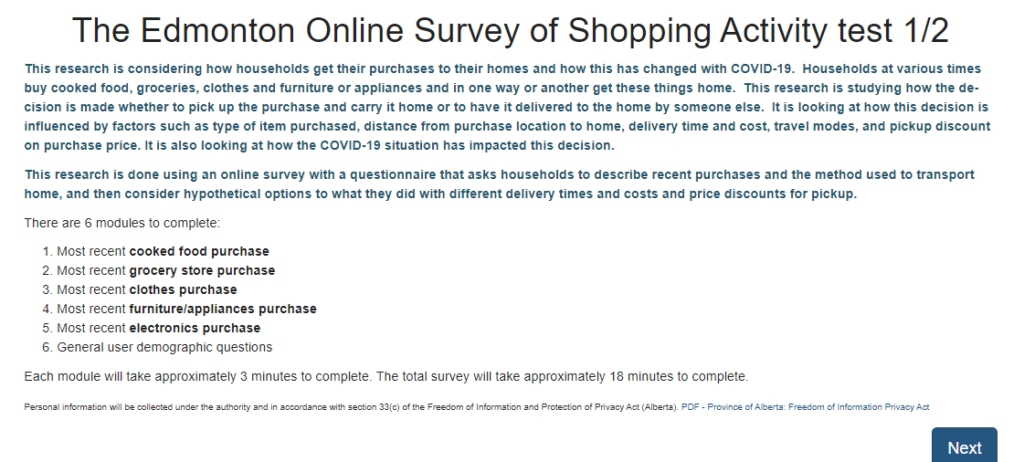
Survey Entry Page
Description of survey, outline of modules and approximate length

Survey Modules
Landing page of Module 4: Most recent Furniture/Appliance purchase

Revealed Preference Questions
Three questions from the cooked food module
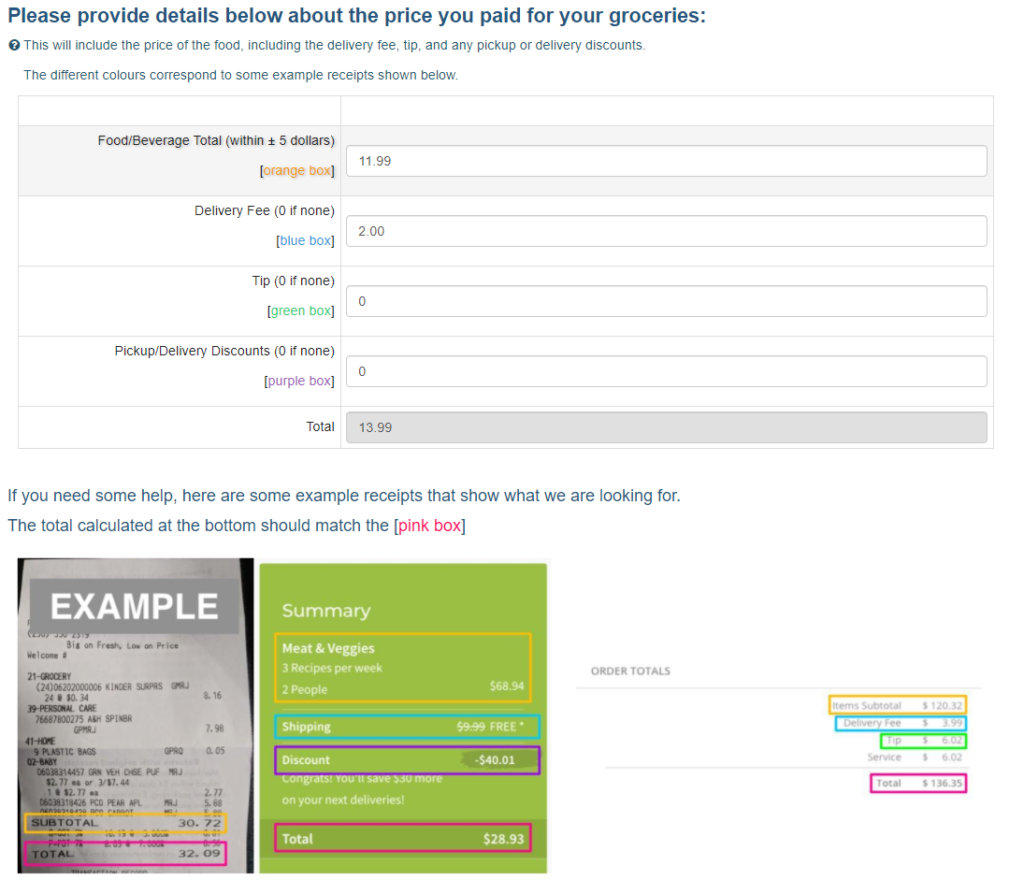
Revealed Preference Questions
“Fill In Receipt” question from the Groceries module
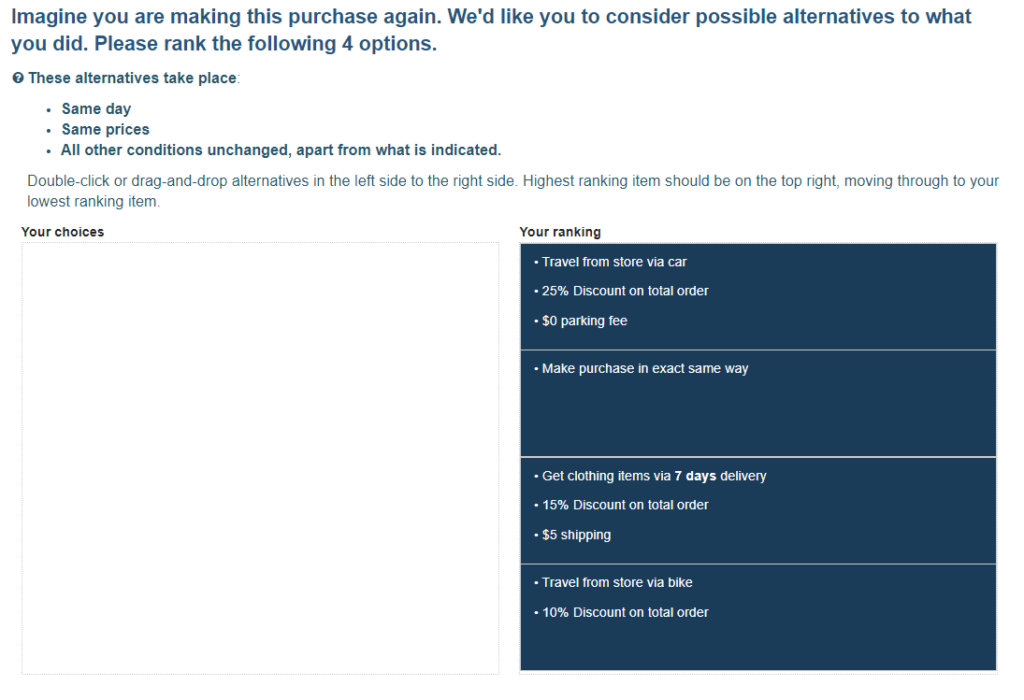
Stated Preference Questions
Completed / ranked stated preference alternatives from the Clothes module
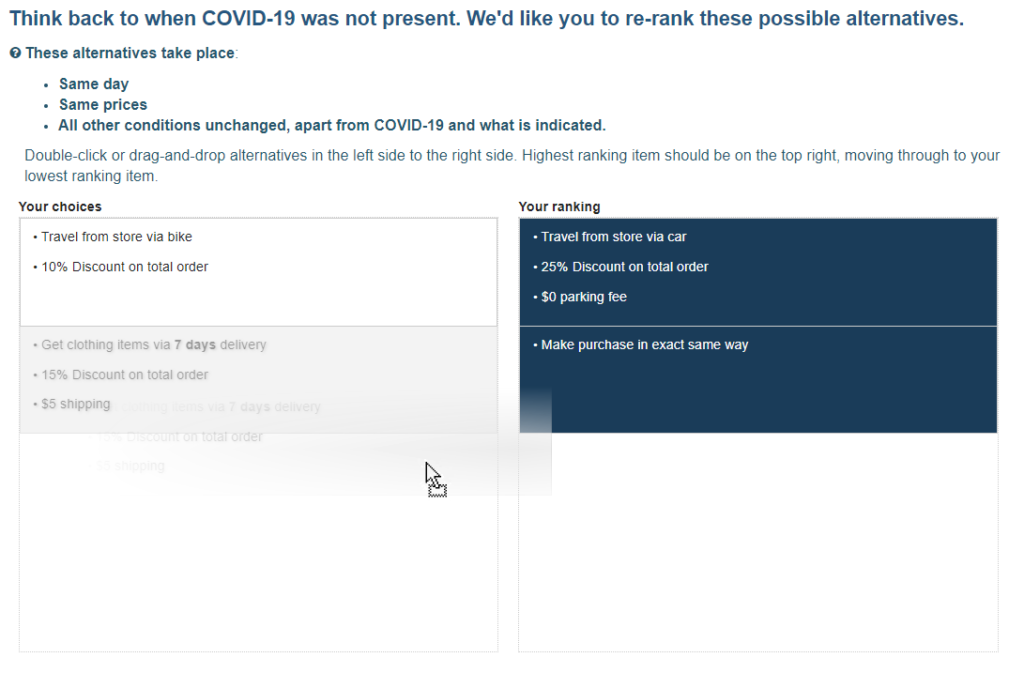
Stated Preference Questions
Same stated preference question as above, but with no COVID-19 present. Drag-and drop to rank alternatives.
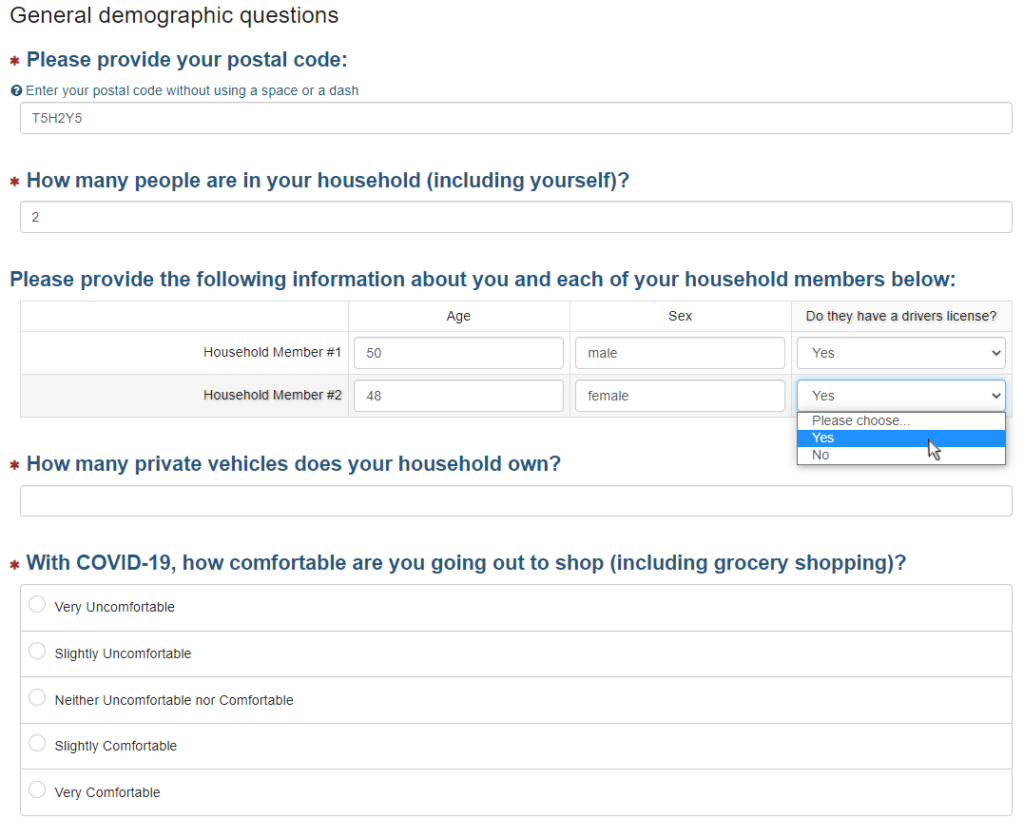
Demographic Questions
Survey completes with demographic questions to obtain general information about household
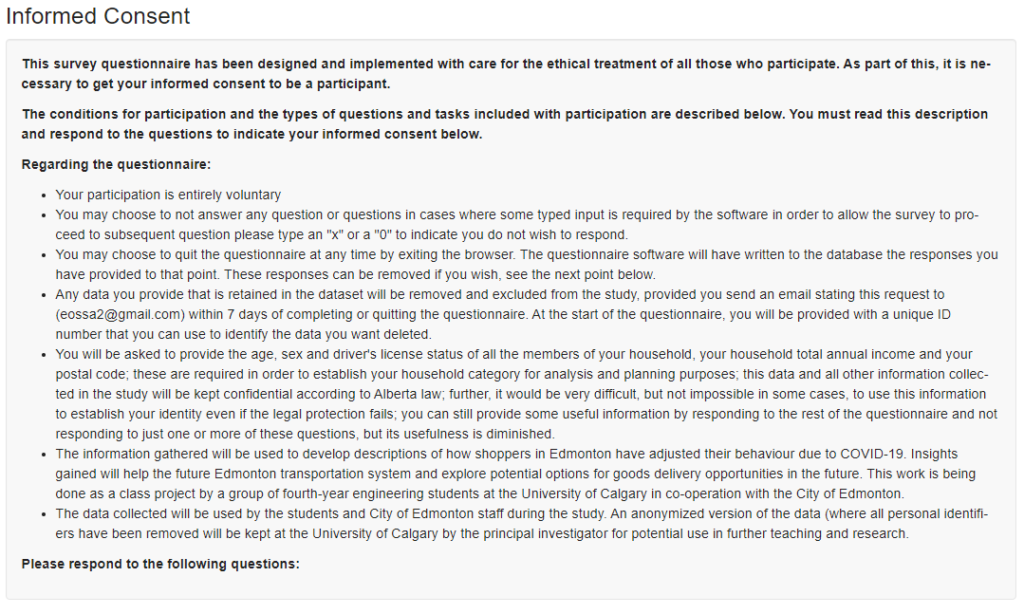
Informed Consent
Respondents must agree with and be made aware of how the data will be used by the City of Edmonton
